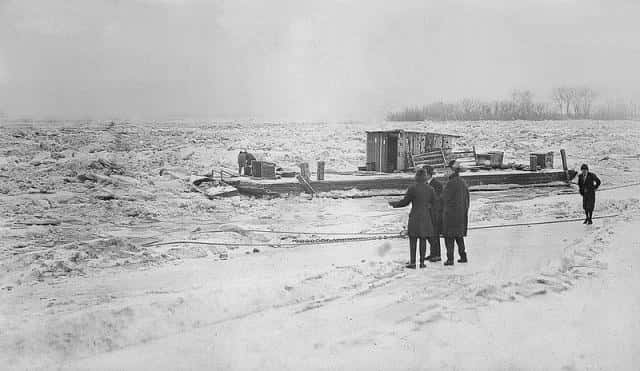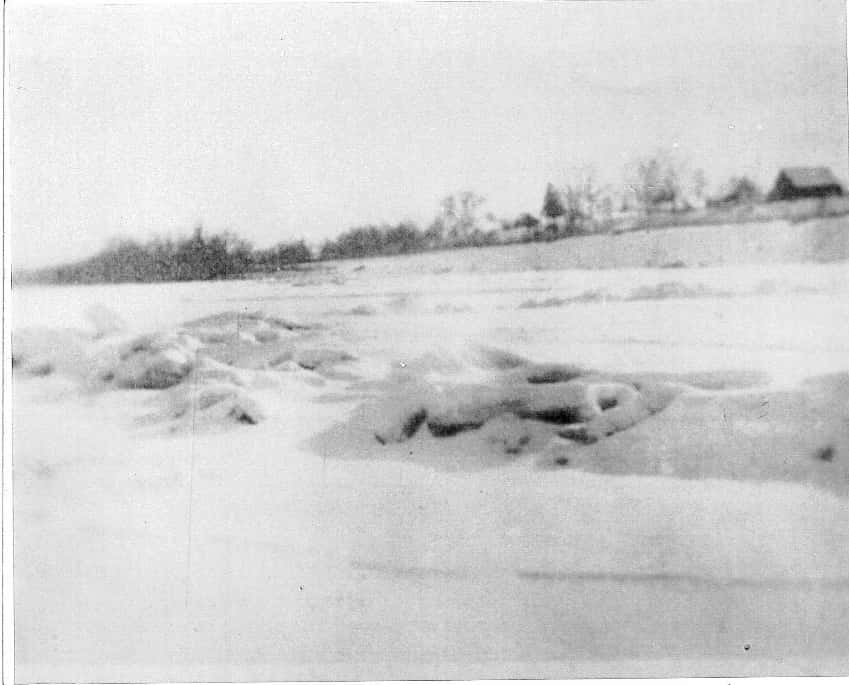Remembering Harsh Winters of the Past
Written by Justin D. Lamb

The Ohio River at Paducah during the harsh winter of 1918.
“The roughest winter I ever seen was in 1917-1918,” recalled Marshall County resident Bernie Brown (now deceased) in a 1978 interview with the Tribune-Courier. “That was the year we had six feet of snow and the Tennessee River froze solid from bank to bank. I walked all the way across the river just to see if I could. The ice was two feet thick.” Brown continued.
The heavy snow started in early December and lasted well on until the end of February. On December 8, 1917, officials reported in the Hopkinsville Kentuckian, 13 inches of snow from Paducah to Benton on through Cadiz and Hoptown.
The weather was so cold, 18 below in Marshall County and 40 mph winds, burials were placed on temporary hold until the ground thawed out. “I remember that it was so cold that a man and woman died of the flu here in Benton that winter, and the ground was frozen so hard that we couldn’t bury ‘em for three weeks.” Bernie Brown remembered.
Despite the frigid weather, life had to continue. “We had to shovel some pretty deep snow to get to the barn.” Brown recalled. “Thankfully I didn’t lose any livestock that year, but I remember that the night the snow fell, I had 50 fat geese running in the pasture. I had to gather them up and put them in the barn. The next morning when I went to the barn to feed the animals, I opened the door and all those geese jumped outside and landed in the snow. It was so deep that the geese couldn’t walk so they started trying to swim! “
The towering snow and frigid temperatures crippled the region for days. In Paducah, the city came to a screeching halt due to the high snow totals. The deepest drift was reported at Broadway Methodist Church which measured at 12 feet deep.
Another firsthand account of the snowstorm in the area comes from the Livingston County Court Order Book W which reads: Friday, 11 January 1918: … the weather at this time is severely bad that one of the worst Blizzards known to this country is now raging, snow being from 10 to 40 inches deep, and still snowing …
According to a 2013 article in Paducah Life Magazine, the Ohio River froze completely over. According to NOAA, it is very rare for large bodies of water found a lower elevations like the Ohio and Tennessee Rivers to freeze. The earliest recording of the Ohio and Tennessee Rivers freeze was in 1856.
One historic account of the 1856 winter tells that a slave woman named Margaret Garner, who escaped from Boone County, Kentucky, walked on foot on the Ohio River to Cincinnati where she lived with a free man. Many reports of the winter of 1918 state that people walked over the frozen Ohio River while others hiked or drove Model Ts on the ice to nearby Brookport, Illinois.
Many became trapped in their own homes by the towering snow. The major concern for officials in Paducah was getting coal, the primary heating source of the day, to residents. The Paducah Street Department and Police Department worked around the clock trying to clear the streets and the city fire department used horses to deliver the coal to residents.

Tennessee River froze over at Birmingham in Marshall County during winter of 1917-1918
By the end of January 1918, temperatures finally began to warm and rain arrived which helped melt away the snow and ice. However, the warming temperatures began to create a new problem on the local rivers. At dawn on January 29, 1918, the massive ice jam broke loose on the Ohio River at Paducah causing several steamboats and barges to drift away and sink and the deafening sound was heard as far away as 25 miles away in Mayfield. The Paducah News-Democrat reported that the noise of the ice jam break sounded like “the approach of a ponderous freight train, accompanied by the sharp clashing together of the huge cakes of ice that resembled the explosion of many giant guns.”
Paducah Life Magazine described the maritime accident, “Docked ships were ripped from their moorings and were swept away. Unmanned craft flew through the ice and water, slamming into one another. The worst of the damage occurred on the Mississippi between Cairo and Hickman. Many ships made their way to the Memphis area where they eventually sank. Men stood on bridges near Cairo counting and attempting to identify ships and pieces of ships as they flew by.” Fortunately no one was killed, but the damages were estimated close to $15 million.
